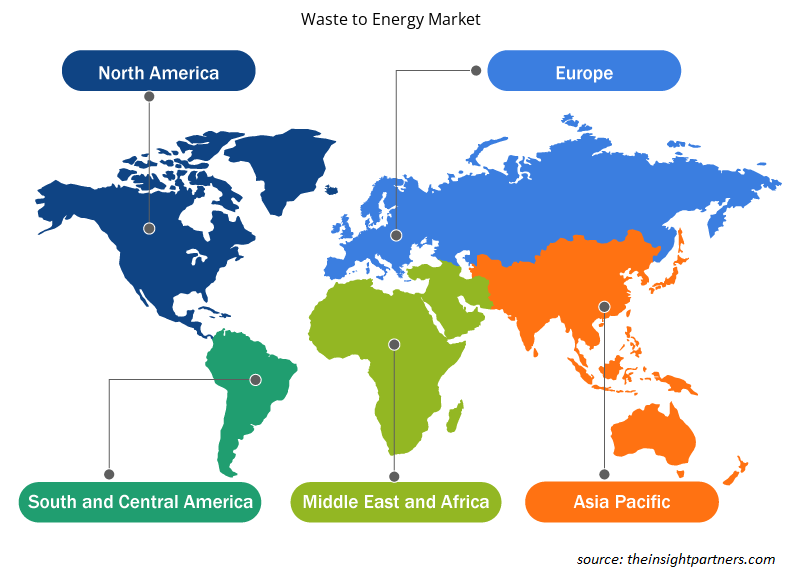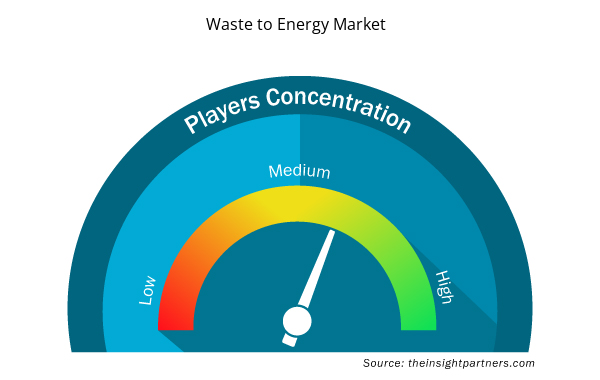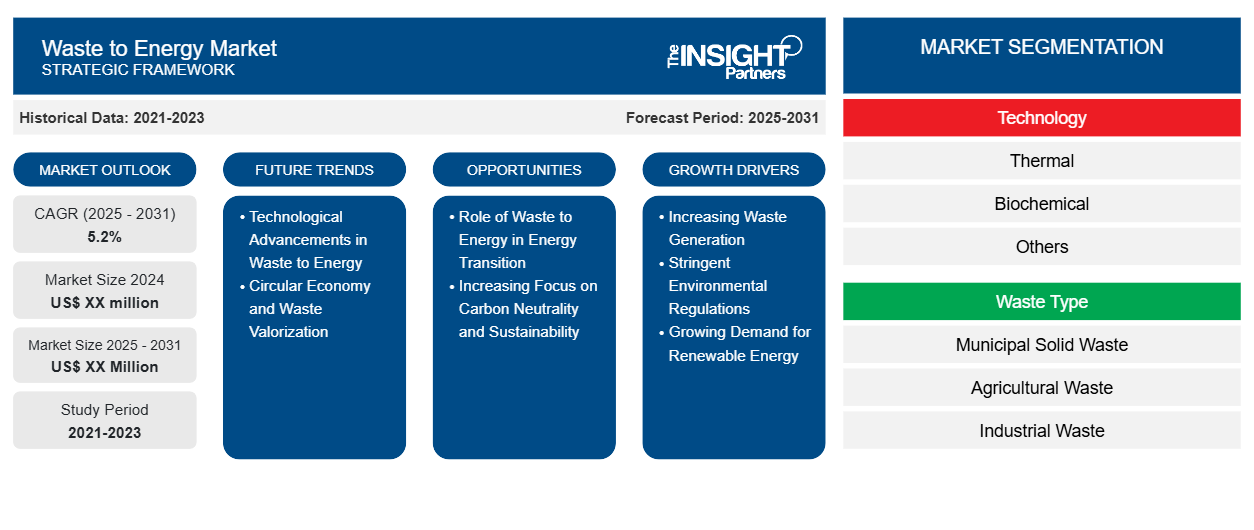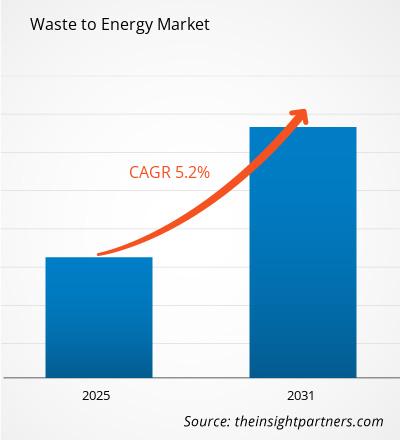Si prevede che il mercato della conversione dei rifiuti in energia registrerà un CAGR del 5,2% dal 2023 al 2031, con una dimensione di mercato in espansione da XX milioni di dollari USA nel 2023 a XX milioni di dollari USA entro il 2031.
Il report è segmentato per tecnologia (termica, biochimica, altre). Il report presenta inoltre un'analisi basata sul tipo di rifiuti (rifiuti solidi urbani, rifiuti agricoli, rifiuti industriali, altri). Il report presenta inoltre un'analisi basata sull'applicazione (generazione di elettricità, riscaldamento, trasporto). L'analisi globale è ulteriormente suddivisa a livello regionale e nei principali paesi. Il report offre il valore in USD per l'analisi e i segmenti di cui sopra.
Scopo del rapporto
Il report Waste to Energy Market di The Insight Partners mira a descrivere il panorama attuale e la crescita futura, i principali fattori trainanti, le sfide e le opportunità. Ciò fornirà spunti a vari stakeholder aziendali, come:
- Fornitori/produttori di tecnologia: per comprendere le dinamiche di mercato in evoluzione e conoscere le potenziali opportunità di crescita, consentendo loro di prendere decisioni strategiche informate.
- Investitori: condurre un'analisi completa delle tendenze in merito al tasso di crescita del mercato, alle proiezioni finanziarie del mercato e alle opportunità esistenti lungo la catena del valore.
- Enti di regolamentazione: regolamentano le politiche e le attività di controllo sul mercato allo scopo di ridurre al minimo gli abusi, preservare la fiducia degli investitori e sostenere l'integrità e la stabilità del mercato.
Segmentazione del mercato dei rifiuti in energia
Tecnologia
- Termico
- Biochimico
- Altri
Tipo di rifiuto
- Rifiuti solidi urbani
- Rifiuti agricoli
- Rifiuti industriali
- Altri
Applicazione
- Generazione di elettricità
- Riscaldamento
- Trasporti
Geografia
- America del Nord
- Europa
- Asia-Pacifico
- America del Sud e Centro
- Medio Oriente e Africa
Geografia
- America del Nord
- Europa
- Asia-Pacifico
- America del Sud e Centro
- Medio Oriente e Africa
Personalizza questo report in base alle tue esigenze
Riceverai la personalizzazione gratuita di qualsiasi report, comprese parti di questo report, o analisi a livello nazionale, pacchetto dati Excel, oltre a usufruire di grandi offerte e sconti per start-up e università
- Scopri le principali tendenze di mercato in questo rapporto.Questo campione GRATUITO includerà analisi di dati che spaziano dalle tendenze di mercato alle stime e alle previsioni.
Fattori trainanti della crescita del mercato dei rifiuti in energia
- Aumento della produzione di rifiuti: con l'aumento delle popolazioni urbanizzate e delle economie industrializzate, a livello globale, la quantità di rifiuti generati è su una scala sempre crescente. Le pressioni per le discariche e i vecchi sistemi di gestione dei rifiuti aumentano insieme a questa tendenza crescente. La tecnologia WtE fornisce quindi una risposta a una sfida critica posta dai rifiuti in continuo aumento, producendo elettricità allo stesso tempo. Con le discariche che diventano sovraffollate e le normative sempre più severe sullo smaltimento dei rifiuti, la conversione dei rifiuti in energia è diventata l'alternativa preferita, il che ha contribuito alla crescita del mercato WtE.
- Normative ambientali severe: i governi di tutto il mondo stanno imponendo normative ambientali più severe per controllare l'impatto ambientale delle pratiche di gestione dei rifiuti. Le vecchie tecnologie come la discarica e l'incenerimento senza recupero energetico sono sempre più vietate o regolamentate in quanto degradanti per l'ambiente con effetti dannosi sulla contaminazione del suolo e sulle emissioni di metano. Le normative spingono le tecnologie WtE a colmare questa lacuna in quanto aiutano a ridurre il volume dei rifiuti, abbassano le emissioni e supportano l'obiettivo di riduzione del carbonio, stimolando così la domanda di soluzioni WtE.
- Domanda crescente di energia rinnovabile: c'è un crescente spostamento globale verso fonti di energia rinnovabile mentre i paesi si sforzano di raggiungere i loro obiettivi climatici e ridurre la dipendenza dai combustibili fossili. La conversione dei rifiuti in energia è considerata una fonte di energia rinnovabile perché riduce gli sprechi durante la generazione di elettricità, calore o combustibili. La crescente enfasi sull'adozione di energia rinnovabile, insieme alla necessità di diversificare le fonti energetiche, ha creato una forte domanda di tecnologie WtE. WtE è, quindi, una delle soluzioni promettenti che possono essere utilizzate in combinazione con altre fonti rinnovabili come l'energia solare, eolica e idroelettrica.
Tendenze future del mercato dei rifiuti in energia
- Progressi tecnologici nella conversione dei rifiuti in energia: i recenti sviluppi nelle tecnologie WtE, tra cui le tecnologie termiche avanzate come la pirolisi e la gassificazione, e i processi biologici, come la digestione anaerobica, hanno aperto importanti opportunità nel mercato. Queste tecnologie stanno diventando efficienti, convenienti e rispettose dell'ambiente. La gassificazione, ad esempio, viene esplorata di più in quanto può trasformare più materiali di scarto in combustibile o elettricità migliori, e la digestione anaerobica è un altro modo promettente per trasformare i rifiuti organici in biogas. Le innovazioni nella cattura del carbonio e nell'efficienza energetica stanno anche aprendo nuove strade per la crescita nel settore WtE.
- Economia circolare e valorizzazione dei rifiuti: il concetto di economia circolare, in cui prodotti e materiali vengono riutilizzati, riparati e riciclati, sta guadagnando molto slancio in tutto il mondo. Le tecnologie WtE si adattano quindi bene a questo schema, poiché non solo aiutano ad affrontare il problema dello smaltimento dei rifiuti, ma generano anche energia e sottoprodotti preziosi come biocarburanti, sostanze chimiche e calore. La valorizzazione dei rifiuti o la massimizzazione del valore dei rifiuti sta guadagnando maggiore attenzione, creando così un potenziale significativo per il mercato WtE. Gli impianti WtE possiedono sia capacità di generazione di energia che di gestione dei rifiuti e quindi svolgono un ruolo importante nell'economia circolare.
Opportunità di mercato per la conversione dei rifiuti in energia
- Ruolo dei rifiuti in energia nella transizione energetica: la transizione energetica è la transizione dalla dipendenza dai combustibili fossili a fonti energetiche rinnovabili e più pulite. Questo cambiamento risponde all'urgente necessità di soluzioni energetiche sostenibili e rispettose dell'ambiente. Negli ultimi decenni si è assistito a un aumento delle emissioni di anidride carbonica (CO2), contribuendo al cambiamento climatico. La transizione verso fonti energetiche rinnovabili e rispettose dell'ambiente è una strategia fondamentale per ridurre queste emissioni e mitigare i danni ambientali. Si prevede che tale transizione energetica mediante la conversione dei rifiuti in energia o combustibile sarà la tendenza futura chiave nel mercato dei rifiuti in energia nei prossimi anni.
- Maggiore attenzione alla neutralità del carbonio e alla sostenibilità: questa attenzione fa parte dello sforzo internazionale per raggiungere gli obiettivi climatici globali e sta diventando sempre più pronunciata attraverso la neutralità del carbonio e le soluzioni energetiche sostenibili. Le tecnologie WtE aiutano a ridurre le emissioni di gas serra poiché deviano i rifiuti dalle discariche, il che riduce le emissioni di metano e genera energia pulita. Le aziende e i paesi che stabiliscono ambiziosi obiettivi di sostenibilità aumenteranno la domanda di soluzioni WtE. Le tecnologie WtE attrezzate per catturare e sequestrare il carbonio saranno sempre più convincenti come parte di una strategia integrata per mitigare gli effetti del cambiamento climatico.
Approfondimenti regionali sul mercato dei rifiuti in energia
Le tendenze regionali e i fattori che influenzano il Waste to Energy Market durante il periodo di previsione sono stati ampiamente spiegati dagli analisti di Insight Partners. Questa sezione discute anche i segmenti e la geografia del Waste to Energy Market in Nord America, Europa, Asia Pacifico, Medio Oriente e Africa, e Sud e Centro America.

- Ottieni i dati specifici regionali per il mercato dei rifiuti in energia
Ambito del rapporto sul mercato dei rifiuti in energia
| Attributo del report | Dettagli |
|---|---|
| Dimensioni del mercato nel 2023 | XX milioni di dollari USA |
| Dimensioni del mercato entro il 2031 | XX milioni di dollari USA |
| CAGR globale (2023-2031) | 5,2% |
| Dati storici | 2021-2022 |
| Periodo di previsione | 2024-2031 |
| Segmenti coperti | Per tecnologia
|
| Regioni e Paesi coperti | America del Nord
|
| Leader di mercato e profili aziendali chiave |
|
Densità degli attori del mercato Waste to Energy: comprendere il suo impatto sulle dinamiche aziendali
Il mercato Waste to Energy Market sta crescendo rapidamente, spinto dalla crescente domanda degli utenti finali dovuta a fattori quali l'evoluzione delle preferenze dei consumatori, i progressi tecnologici e una maggiore consapevolezza dei vantaggi del prodotto. Con l'aumento della domanda, le aziende stanno ampliando le loro offerte, innovando per soddisfare le esigenze dei consumatori e capitalizzando sulle tendenze emergenti, il che alimenta ulteriormente la crescita del mercato.
La densità degli operatori di mercato si riferisce alla distribuzione di aziende o società che operano in un particolare mercato o settore. Indica quanti concorrenti (operatori di mercato) sono presenti in un dato spazio di mercato in relazione alle sue dimensioni o al valore di mercato totale.
Le principali aziende che operano nel mercato Waste to Energy sono:
- Gruppo AEandE GmbH
- Freccia Ecologia Limitata
- Babcock e Wilcox Enterprises Inc. è un'azienda statunitense specializzata in servizi di consulenza e assistenza clienti.
- Costruzioni Industrielles De La Mediterranee SA
- Società energetica Covanta
Disclaimer : le aziende elencate sopra non sono classificate secondo un ordine particolare.

- Ottieni una panoramica dei principali attori del mercato Waste to Energy
Punti chiave di vendita
- Copertura completa: il rapporto affronta in modo completo l'analisi dei prodotti, dei servizi, delle tipologie e degli utenti finali del mercato della conversione dei rifiuti in energia, offrendo una panoramica olistica.
- Analisi degli esperti: il rapporto è compilato sulla base della conoscenza approfondita di esperti e analisti del settore.
- Informazioni aggiornate: il rapporto garantisce la pertinenza aziendale grazie alla copertura di informazioni recenti e tendenze nei dati.
- Opzioni di personalizzazione: questo report può essere personalizzato per soddisfare le esigenze specifiche del cliente e adattarsi in modo appropriato alle strategie aziendali.
Il rapporto di ricerca sul Waste to Energy Market può, quindi, aiutare a guidare il percorso di decodificazione e comprensione dello scenario del settore e delle prospettive di crescita. Sebbene possano esserci alcune preoccupazioni valide, i vantaggi complessivi di questo rapporto tendono a superare gli svantaggi.
- Analisi storica (2 anni), anno base, previsione (7 anni) con CAGR
- Analisi PEST e SWOT
- Valore/volume delle dimensioni del mercato - Globale, regionale, nazionale
- Industria e panorama competitivo
- Set di dati Excel



Report Coverage
Revenue forecast, Company Analysis, Industry landscape, Growth factors, and Trends

Segment Covered
This text is related
to segments covered.

Regional Scope
North America, Europe, Asia Pacific, Middle East & Africa, South & Central America

Country Scope
This text is related
to country scope.
Domande frequenti
Some of the customization options available based on the request are an additional 3-5 company profiles and country-specific analysis of 3-5 countries of your choice. Customizations are to be requested/discussed before making final order confirmation, as our team would review the same and check the feasibility.
The report can be delivered in PDF/PPT format; we can also share excel dataset based on the request.
The leading players operating in the Waste to Energy Market include Mitsubishi Heavy Industries Ltd., A2A S.p.A., Veolia Environnement SA, Martin GmbH, Hitachi Zosen Corp., Ramboll Group A/S, EEW Holding GmbH, Tana Oy, SUEZ, STEAG Energy Services GmbH
Technological Advancements in Waste to Energy is the key future trend of the Waste to Energy Market
The Waste to Energy Market is estimated to witness a CAGR of 5.2% from 2023 to 2031
The major factors driving the Waste to Energy Market are: Increasing Waste Generation and Stringent Environmental Regulations
Trends and growth analysis reports related to Energy and Power : READ MORE..
1. AEandE Group Gmbh2. Arrow Ecology Limited3. Babcock and Wilcox Enterprises Inc.4. Constructions Industrielles De La Mediterranee S.A.5. Covanta Energy Corporation6. Essent N.V.7. Haase Energietechnik AG8. John Wood Group PLC9. Pacific Renewable Fuels Inc10. Qinetiq Group Plc
The Insight Partners performs research in 4 major stages: Data Collection & Secondary Research, Primary Research, Data Analysis and Data Triangulation & Final Review.
- Data Collection and Secondary Research:
As a market research and consulting firm operating from a decade, we have published and advised several client across the globe. First step for any study will start with an assessment of currently available data and insights from existing reports. Further, historical and current market information is collected from Investor Presentations, Annual Reports, SEC Filings, etc., and other information related to company’s performance and market positioning are gathered from Paid Databases (Factiva, Hoovers, and Reuters) and various other publications available in public domain.
Several associations trade associates, technical forums, institutes, societies and organization are accessed to gain technical as well as market related insights through their publications such as research papers, blogs and press releases related to the studies are referred to get cues about the market. Further, white papers, journals, magazines, and other news articles published in last 3 years are scrutinized and analyzed to understand the current market trends.
- Primary Research:
The primarily interview analysis comprise of data obtained from industry participants interview and answers to survey questions gathered by in-house primary team.
For primary research, interviews are conducted with industry experts/CEOs/Marketing Managers/VPs/Subject Matter Experts from both demand and supply side to get a 360-degree view of the market. The primary team conducts several interviews based on the complexity of the markets to understand the various market trends and dynamics which makes research more credible and precise.
A typical research interview fulfils the following functions:
- Provides first-hand information on the market size, market trends, growth trends, competitive landscape, and outlook
- Validates and strengthens in-house secondary research findings
- Develops the analysis team’s expertise and market understanding
Primary research involves email interactions and telephone interviews for each market, category, segment, and sub-segment across geographies. The participants who typically take part in such a process include, but are not limited to:
- Industry participants: VPs, business development managers, market intelligence managers and national sales managers
- Outside experts: Valuation experts, research analysts and key opinion leaders specializing in the electronics and semiconductor industry.
Below is the breakup of our primary respondents by company, designation, and region:

Once we receive the confirmation from primary research sources or primary respondents, we finalize the base year market estimation and forecast the data as per the macroeconomic and microeconomic factors assessed during data collection.
- Data Analysis:
Once data is validated through both secondary as well as primary respondents, we finalize the market estimations by hypothesis formulation and factor analysis at regional and country level.
- Macro-Economic Factor Analysis:
We analyse macroeconomic indicators such the gross domestic product (GDP), increase in the demand for goods and services across industries, technological advancement, regional economic growth, governmental policies, the influence of COVID-19, PEST analysis, and other aspects. This analysis aids in setting benchmarks for various nations/regions and approximating market splits. Additionally, the general trend of the aforementioned components aid in determining the market's development possibilities.
- Country Level Data:
Various factors that are especially aligned to the country are taken into account to determine the market size for a certain area and country, including the presence of vendors, such as headquarters and offices, the country's GDP, demand patterns, and industry growth. To comprehend the market dynamics for the nation, a number of growth variables, inhibitors, application areas, and current market trends are researched. The aforementioned elements aid in determining the country's overall market's growth potential.
- Company Profile:
The “Table of Contents” is formulated by listing and analyzing more than 25 - 30 companies operating in the market ecosystem across geographies. However, we profile only 10 companies as a standard practice in our syndicate reports. These 10 companies comprise leading, emerging, and regional players. Nonetheless, our analysis is not restricted to the 10 listed companies, we also analyze other companies present in the market to develop a holistic view and understand the prevailing trends. The “Company Profiles” section in the report covers key facts, business description, products & services, financial information, SWOT analysis, and key developments. The financial information presented is extracted from the annual reports and official documents of the publicly listed companies. Upon collecting the information for the sections of respective companies, we verify them via various primary sources and then compile the data in respective company profiles. The company level information helps us in deriving the base number as well as in forecasting the market size.
- Developing Base Number:
Aggregation of sales statistics (2020-2022) and macro-economic factor, and other secondary and primary research insights are utilized to arrive at base number and related market shares for 2022. The data gaps are identified in this step and relevant market data is analyzed, collected from paid primary interviews or databases. On finalizing the base year market size, forecasts are developed on the basis of macro-economic, industry and market growth factors and company level analysis.
- Data Triangulation and Final Review:
The market findings and base year market size calculations are validated from supply as well as demand side. Demand side validations are based on macro-economic factor analysis and benchmarks for respective regions and countries. In case of supply side validations, revenues of major companies are estimated (in case not available) based on industry benchmark, approximate number of employees, product portfolio, and primary interviews revenues are gathered. Further revenue from target product/service segment is assessed to avoid overshooting of market statistics. In case of heavy deviations between supply and demand side values, all thes steps are repeated to achieve synchronization.
We follow an iterative model, wherein we share our research findings with Subject Matter Experts (SME’s) and Key Opinion Leaders (KOLs) until consensus view of the market is not formulated – this model negates any drastic deviation in the opinions of experts. Only validated and universally acceptable research findings are quoted in our reports.
We have important check points that we use to validate our research findings – which we call – data triangulation, where we validate the information, we generate from secondary sources with primary interviews and then we re-validate with our internal data bases and Subject matter experts. This comprehensive model enables us to deliver high quality, reliable data in shortest possible time.


 Ottieni un campione gratuito per questo repot
Ottieni un campione gratuito per questo repot